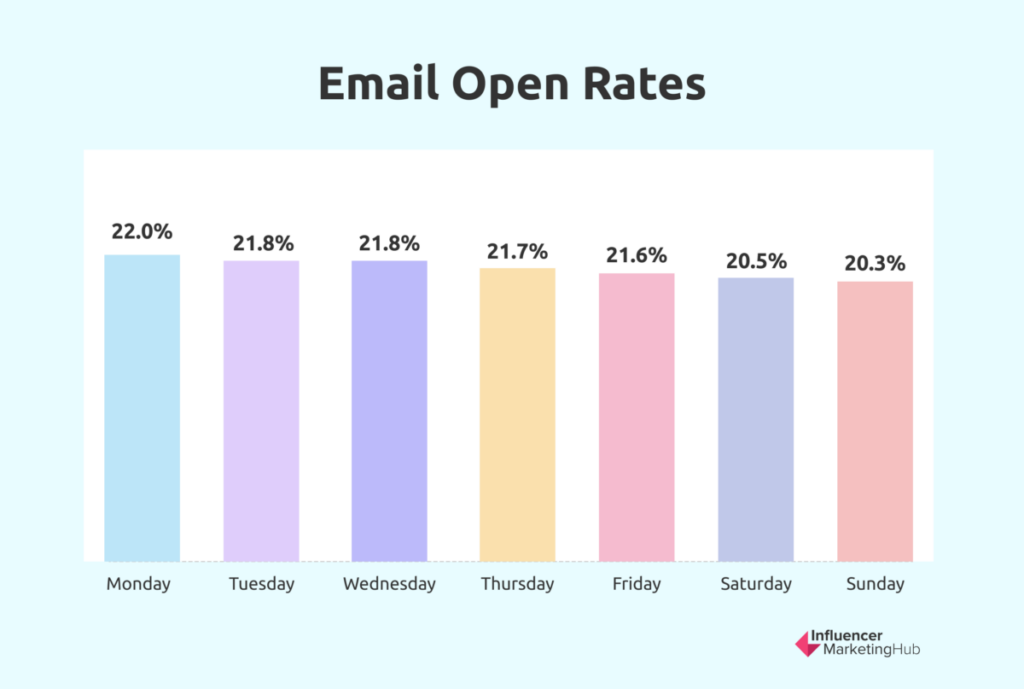Email marketing is one of the oldest marketing techniques that has managed to stay relevant even as the marketing landscape has completely changed. The beauty of email marketing lies in its simplicity and the fact that it allows you to connect with your audience directly.
If you already use email marketing, then you can read these statistics to see how you’re performing compared to other marketers. Whatever you’re looking for, this is the most comprehensive and updated list of email marketing statistics that you will find.
Email Marketing Usage
1. In 2026, the number of email users worldwide is projected to grow to 4.73 billion, making up a little more than half of the current global population.
2. In 2020, the global daily count of sent and received emails reached approximately 306 billion. It is estimated that more than 376.4 billion emails will be exchanged per day in 2025.

3. 46% of marketers consider email marketing an important lead generation tactic, while 47% consider it important for lead nurturing.
4. Mobile devices are the most popular reading medium for emails.
Given the sheer number of email users, it is too big of a platform for marketers to ignore. Marketers are using emails for both lead generation and nurturing. And, as the use of email grows, so will email marketing.
Email Marketing ROI and Metrics Tracking
In this section, let’s take a look at some of the statistics that tell us how marketers are measuring ROI and which metrics they track for email marketing.
5. 73% of global marketers consider email marketing as an excellent marketing channel. This is higher than SEO (72%) and paid search (67%).
6. And yet, 70% of brands fail to measure their email marketing ROI well.
7. Most marketers track only popular metrics like opens (98.9% of marketers), clicks (98.9%), and bounces (92.5%), per a study by Litmus.
8. The same study found that over 75% of marketers also track conversions, email deliverability, and spam complaints.
9. However, only 46.7% track ROI and only 27.7% measure the subscriber lifetime value.
10. Marketers understand this gap in tracking the right metrics and plan to track the following metrics more:

Image Source: Litmus
Open and Click Rates
11. Per a MailChimp study of their customers around the world, the average open rate for emails is 21.33%.
12. Per the same study, the average click rate across all industries and customers for MailChimp was 2.62%.
13. The average unsubscribe rate, according to the MailChimp study, was 0.26%.
You can compare your email marketing campaign’s performance against these benchmarks to see how you’re doing. Based on these statistics, you can determine where you’re lacking and take measures to improve in those areas. Take note, however, that email open rates and click rates vary across different industries. For a better understanding of your email marketing performance, you can check out the open and click rates by industry.
Email Deliverability
Email deliverability is an important aspect when it comes to email marketing. Your initiatives will only work if your emails get delivered to your subscriber’s primary inboxes. Let’s take a look at how marketers are doing in this regard and if email marketing platforms can help.
14. As of April 2022, the average email deliverability rate was 84.2% across various email marketing platforms tested, per this study. This marks a 4.7% decrease from the same period last year.
15. According to this source, 20.4% of all emails either go to spam or remain undelivered (on average).
16. The top five email marketing platforms in decreasing order of email deliverability are:
- MailerLite - 98%
- CleverReach – 96.5%
- Constant Contact - 90.9%
- ActiveCampaign – 90.2%
- Sendinblue - 90%
Pro tip: Use trusted email marketing tools that have shown proven results in improving email deliverability. Also, take measures to ensure that your emails are relevant and do not have any elements that may get them marked as spam.
Best Days to Send Emails
Just like there are better times to post on social media, there are better days to send emails. According to the latest 2022 data from Campaign Monitor:
17. Emails sent on Mondays get the highest open rates of 22%.
18. Wednesdays and Tuesdays get the highest click-to-open rates of 10.8%.

Email open rates
19. Click-through rates hover between 2.1% and 2.4% for all days, with Saturdays and Sundays at the low end and Tuesdays at the high end.
In general, people read their emails more actively on weekdays than on weekends. Monday, overall, is the best day to send an email. So, if you plan on sending weekly emails, you will likely get much more opens on Mondayy than on any other day.
Email Marketing Challenges
20. Per a Litmus poll, here are the top email marketing challenges that marketers face:

Image Source: Litmus
B2B Email Marketing Statistics
21. Despite its powerful role in B2B marketing, email is not without its hurdles. A significant portion of emails - 15.8% - either end up missing or caught in the crosshairs of popular spam filters.
22. The same study also found that 51% of the most successful B2B marketers in North America use partner emails to promote their content.
23. Per the research conducted by the Content Marketing Institute, 75% of B2B marketers used email marketing software as a content marketing tool, just behind analytics tools and social media.
24. The same study found that aside from their own website, B2B companies rely the most on blogs, email newsletters, and other email marketing techniques to distribute their content.
25. Because of the pandemic and work-from-home setup, more B2B companies started focusing on online strategies such as email marketing, SEO, and SEM to get results. Among the respondents, 64% said that email engagement provided significant insight into marketing performance.
26. 50% of B2B marketers in one study say that emails generate leads with the highest ROI, with 64% saying that it is the most important technique to nurture leads.
B2C Email Marketing Statistics
27. CMI research study of B2C marketers in North America revealed that 74% of them use emails to nurture their audiences.
28. In the same report, CMI discovered that email newsletters ranked first in terms of securing and nurturing leads for B2C companies. It ranked second in converting leads with 21%, with in-person events topping the survey at 22%.
29. 79% of these marketers use emails as an organic way to distribute content effectively, along with social media and the organization’s website.
30. Other types of emails they use include event emails (55%), promotional (52%), and newsletters (48%).
Email Marketing Trends and Best Practices
Marketers are starting to realise that it is futile to keep sending emails to inactive subscribers and are actively taking steps to avoid that, per a Litmus report.
31. In 2018, 51.9% of marketers removed inactive subscribers from their email lists.
32. Most of these marketers remove inactive subscribers after a maximum inactivity period of 15 months.
33. 44.4% of marketers who remove inactive subscribers send re-permission emails before removing subscribers.
34. 48.4% of marketers also try to win these inactive subscribers back via re-engagement emails.
According to the Email Marketing Census 2019, a global survey, done by Econsultancy:
35. The three focus areas for marketers are advanced segmentation (for 47% of marketers), content personalisation (37%), and behavioural targeting (39%).
36. 66% of marketers consider email automation to be the most important factor for improving email marketing effectiveness.
37. The areas that marketers will focus on in the future are automated email campaigns (37% of marketers), personalisation (32%), and segmentation (29%).
Another study by GetResponse confirmed the effectiveness of automation and personalisation.
38. According to them, automated (triggered) emails get the highest open rates (44.05%) and click rates (10.39%).
39. Also, personalised emails get higher open rates of 22.63% than the ones that are not personalised (22.09%).
40. Use of emojis in subject lines also improves open rates (25.02% of those with emojis and 22.03% for those without). This applies mainly to B2C companies, however. Use emojis on B2B marketing emails with discretion; your branding and target audience should be considered in crafting subject lines with emojis.
This clearly shows that the future of email marketing will be driven by automation and personalisation. Campaigns will become hyper-targeted and more effective.
Email Marketing Effectiveness
41. Email marketing can get you an ROI of as high as $44 for every dollar that you spend on it, or an average of $42.
If that is not enough reason to start investing in email marketing, then nothing else is. So, if you haven’t yet tried email marketing, it’s time that you start doing so right now.
Conclusion
You now have a whole list of email marketing statistics that you can learn from.
You can understand the industry trends and best practices and apply them for your next email marketing campaign. You can also use insights from these to fuel your next email marketing strategy. Or you can simply use these to stay updated on industry statistics.
Frequently Asked Questions
Is email marketing important?
Email marketing is extremely important. Email marketing can get you a ROI of as much as $44 for every dollar that you spend on it. Marketers cannot afford to ignore email marketing as it is simply just too big of a platform. In 2020, it was estimated that more than 306 billion emails were sent and received per day. It is expected that by the end of 2026 there will be 4.73 billion email users.
When is the best day to send a marketing email?
All things considered, the best day to send an email is on a Tuesday. Emails that are sent on a Tuesday have the highest open rates of 18.3%. So, if you send your email on a Tuesday, more people will most likely open your email. In general, people read their emails more during the week than on a Saturday or Sunday. Other popular weekdays are Thursdays and Fridays that boast the highest click-to-open rates of 14.4%.
Is email automation effective?
The majority (66%) of marketers believe that email automation is the most important factor for improving email marketing effectiveness. According to a study completed by GetResponse, automated (triggered) emails enjoy the highest open rates of 44% as well as click rates of 10.39%. This clearly shows that email automation will drive the future of email marketing. It is so important that 37% of marketers have indicated in the Email Marketing Census 2019 that they will focus on automated email campaigns in the future.
What are the top email marketing challenges?
Poor coordination between other channels and departments is the biggest email marketing challenge that marketers face, according to a Litmus poll. Some of the other biggest challenges that were identified by this poll include insufficient staffing, limitations of the current service provider, bad leadership or strategies and a lack of quality data. While inadequate tools for the email creation process were also identified as a big challenge, this was not as much of an issue and only affected about 12% of the marketers.
How can I improve email deliverability?
Using a trusted email marketing tool can help you to improve your email deliverability. The top five email marketing platforms that can help you with email deliverability are: SendinBlue, Mailjet, ActiveCampaign, Constant Contact and AWeber. In addition to using one of these tools, you must also see to it that your emails are relevant without any elements that may get them marked as spam.


